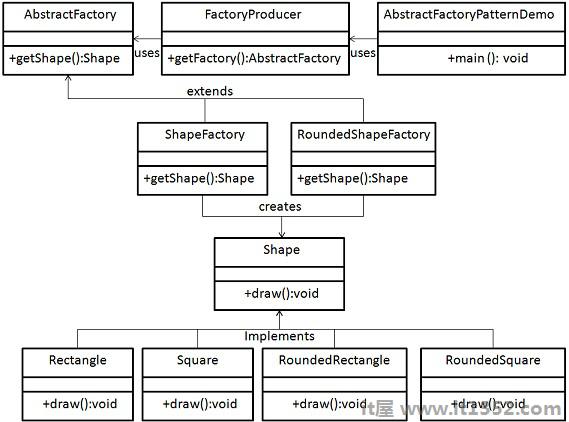抽象工厂模式围绕着一个创造其他工厂的超级工厂.这家工厂也被称为工厂工厂.这种类型的设计模式属于创建模式,因为此模式提供了创建对象的最佳方法之一.
在抽象工厂模式中,接口负责创建相关对象的工厂而不用明确指定他们的类.每个生成的工厂都可以按照工厂模式给出对象.
我们将创建一个 Shape 和 Color 接口以及实现这些接口的具体类.我们创建一个抽象工厂类 AbstractFactory 作为下一步.定义工厂类 ShapeFactory 和 ColorFactory ,其中每个工厂扩展 AbstractFactory .创建工厂创建者/生成器类 FactoryProducer .
AbstractFactoryPatternDemo ,我们的演示类使用 FactoryProducer 来得到一个 AbstractFactory 对象.它会将信息( CIRCLE/RECTANGLE/SQUARE 为 Shape )传递给 AbstractFactory 以获取所需的对象类型.它还将信息( RED/GREEN/BLUE 用于 Color )传递给 AbstractFactory 以获取所需对象的类型.

为形状和颜色创建一个界面.
Shape.java
public interface Shape {
void draw();
}创建实现相同界面的具体类.
RoundedRectangle.java
public class RoundedRectangle implements Shape {
@Override
public void draw() {
System.out.println("Inside RoundedRectangle::draw() method.");
}
}RoundedSquare.java
public class RoundedSquare implements Shape {
@Override
public void draw() {
System.out.println("Inside RoundedSquare::draw() method.");
}
}Rectangle.java
public class Rectangle implements Shape {
@Override
public void draw() {
System.out.println("Inside Rectangle::draw() method.");
}
}创建一个抽象类以获取正常工厂和圆形形状对象.
AbstractFactory.java
public abstract class AbstractFactory {
abstract Shape getShape(String shapeType) ;
}创建工厂类,扩展AbstractFactory以根据给定生成具体类的对象信息.
ShapeFactory.java
public class ShapeFactory extends AbstractFactory {
@Override
public Shape getShape(String shapeType){
if(shapeType.equalsIgnoreCase("RECTANGLE")){
return new Rectangle();
}else if(shapeType.equalsIgnoreCase("SQUARE")){
return new Square();
}
return null;
}
}RoundedShapeFactory.java
public class RoundedShapeFactory extends AbstractFactory {
@Override
public Shape getShape(String shapeType){
if(shapeType.equalsIgnoreCase("RECTANGLE")){
return new RoundedRectangle();
}else if(shapeType.equalsIgnoreCase("SQUARE")){
return new RoundedSquare();
}
return null;
}
}创建一个Factory生成器/生成器类来获取工厂通过传递诸如Shape的信息
FactoryProducer.java
public class FactoryProducer {
public static AbstractFactory getFactory(boolean rounded){
if(rounded){
return new RoundedShapeFactory();
}else{
return new ShapeFactory();
}
}
}使用FactoryProducer获取AbstractFactory以通过传递类型等信息来获取具体类的工厂.
AbstractFactoryPatternDemo.java
public class AbstractFactoryPatternDemo {
public static void main(String[] args) {
//get rounded shape factory
AbstractFactory shapeFactory = FactoryProducer.getFactory(false);
//get an object of Shape Rounded Rectangle
Shape shape1 = shapeFactory.getShape("RECTANGLE");
//call draw method of Shape Rectangle
shape1.draw();
//get an object of Shape Rounded Square
Shape shape2 = shapeFactory.getShape("SQUARE");
//call draw method of Shape Square
shape2.draw();
//get rounded shape factory
AbstractFactory shapeFactory1 = FactoryProducer.getFactory(true);
//get an object of Shape Rectangle
Shape shape3 = shapeFactory1.getShape("RECTANGLE");
//call draw method of Shape Rectangle
shape3.draw();
//get an object of Shape Square
Shape shape4 = shapeFactory1.getShape("SQUARE");
//call draw method of Shape Square
shape4.draw();
}
}验证输出.
Inside Rectangle::draw() method. Inside Square::draw() method. Inside RoundedRectangle::draw() method. Inside RoundedSquare::draw() method.